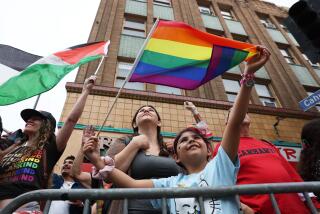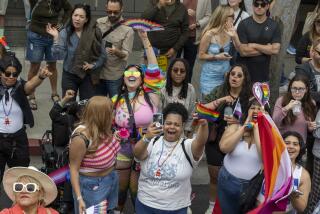Feelings mixed as marches near
- Share via
City officials are bracing for thousands of marchers to converge Tuesday on Central Los Angeles in two separate May Day rallies for immigration reform and labor rights, gatherings that are stirring anticipation among immigrant-rights advocates but anxiety, even anger, among some business owners.
Although organizers predict much smaller crowds than the roughly 650,000 who participated last year, city officials are nevertheless urging the public to avoid downtown, where one of the events will occur. They are warning that the downtown march will snarl traffic for hours, disrupt more than 60 bus lines and halt some public business, including the high-profile murder trial of music producer Phil Spector. City managers have been asked to allow employees to take vacation days or work from alternative sites.
Organizers say much of the anger that motivated marchers nationwide last year was alleviated after congressional legislation that would have criminalized illegal immigrants and toughened border enforcement failed to win passage.
“Last year was a once-in-a-lifetime mobilization,” said Mike Garcia, president of Local 1877 of the Service Employees International Union in Los Angeles. “We wanted to show the willingness of immigrants to march across the country for their rights. This year, people are focusing on the work of voter registration and civic participation.”
Organizers have said on their official march permits this year that they expect crowds of about 100,000 downtown and 15,000 for the other event, a couple of miles to the west.
But transportation and law enforcement officials are still bracing for the downtown march to be Los Angeles’ largest so far this year and are planning for as many as 500,000 participants, said city transportation official Marco Arroyo.
The city’s street closure plans have prompted numerous complaints from hotels, merchants and other businesses, officials said. The closures will begin about 8 a.m. Tuesday, forcing buses on 17 downtown streets to detour and drop off passengers several blocks from their usual destinations. Light-rail service will be increased.
“It’s a mess,” said Don Baumgartner, special events coordinator for the Los Angeles County Metropolitan Transportation Authority, which operates bus and rail service.
Rallies and boycotts are expected to take place around the nation as well, but March 25 Coalition spokesman Javier Rodriguez said the number of participating cities was expected to fall by half to about 75 this year.
Rodriguez said that immigration-rights advocates, although united on the end goal of legalization for the nation’s 11 million undocumented migrants and more family and worker visas, have splintered over differing priorities and strategies. Those differences are reflected in the two May Day events in Los Angeles.
The March 25 Coalition, which Rodriguez described as the “more militant wing” of the pro-immigrant movement, is pushing a boycott of work, school and all consumer spending Tuesday. It is also opposing bipartisan immigration reform legislation recently introduced by U.S. Reps. Luis V. Gutierrez (D-Ill.) and Jeff Flake (R-Ariz.) as a sellout to corporate interests that would not adequately secure migrant rights. The coalition’s march is scheduled to depart at 10 a.m. from Olympic Boulevard and Broadway for City Hall.
The second march is organized by the Multi-ethnic Immigrant Workers Organizing Network, a consortium of labor, religious and community groups. Plans call for participants to leave 3rd Street and Vermont Avenue at 2 p.m. and march on sidewalks to a 5:30 p.m. rally at MacArthur Park.
Many of the network’s members regard the bipartisan bill as promising though flawed, have not embraced a boycott and are urging students to stay in school. In a news conference today at Marshall High School, State Supt. of Public Instruction Jack O’Connell is also set to ask that students pursue activism in other ways than leaving campus.
“The overall message is: We want kids to stay in school,” said Nadia Gonzalez, spokeswoman for the Los Angeles Unified School District. “But we’re not by any means saying that the marches are not important.... We’d rather kids be safe in school where they can learn.”
District officials have provided educational materials on immigrant rights and are encouraging students to discuss the issue in classrooms or on-campus forums. They estimate that as many as 24,000 students left campus in March 2006 at the height of the student walkouts.
In Santa Ana, the Orange County Alliance for Immigrants’ Rights, an umbrella group of 20 organizations, is sponsoring a march Tuesday from the Plaza of Flags downtown to 17th and Bristol streets and back beginning at 3 p.m. Turnout is expected to fall short of the 15,000 people the event drew last year but still amount to several thousand people, said Nativo Lopez, president of Hermandad Mexicana, an immigrant advocacy organization.
Lopez and others said increased workplace immigration raids have scared off potential participants. Others, including many of the Spanish-language radio DJs who were instrumental in mobilizing masses of marchers last year, have shifted their focus from marches to legislative lobbying, voter registration and citizenship drives.
The movement’s diffuse strategies have left many immigrants wrestling with decisions about which march to join or whether to participate at all.
Claudia Perez-Ansurez, manager of the Taqueria La Papa Loca on East Olympic Boulevard in Los Angeles, is shutting down for the day so she and her five employees can march together.
“I’m close to my workers and know what they’ve been going through, as a Latino working hard to make ends meet,” said Perez-Ansurez, a 31-year-old Chicago native.
But clothing shop saleswoman Sara Hernandez worried that the march might hurt more than help.
“I think when people see us all out there and how many of us exist among them, it can be scary,” said Hernandez, a 35-year-old Mexico City native. “I don’t know if the marches are the best way to push our hope for better treatment.”
Delarmeno Martha, a 23-year-old restaurant dishwasher, earns just $1,000 a month and sends a fifth of that home to his family in Mexico. But Martha, who illegally immigrated three years ago, said he’s planning to take the day off to march, as he did last year to press for legalization and more rights for low-wage workers.
“I’m a total optimist and think if people get to know us, they wouldn’t fear us wanting to be in their country,” Martha said.
Business owners are also weighing what to do Tuesday.
In the downtown jewelry district, the writing is literally on the wall: Several signs announce that business will shut down for the day because of the march. At the Great Western Plaza on 7th Street, Michael Naim said he and other jewelry tenants planned to close to protect their shops from possible damage by the crowds.
“I sympathize, being an immigrant,” said Naim, a native of Iran who owns the Boots kiosk at the plaza. “Business has been slower this year, so the hit shouldn’t be as bad.”
Other business owners, however, are fed up with the whole march spectacle. Cia Amir, a Panama native who runs a pizza shop at 6th Street and Broadway, said he opened his shop last May Day until throngs of passing marchers demanded that he close, frightening him by banging on his windows. He expects to lose thousands of dollars when he shuts down his shop again Tuesday.
Earlier this year he sent a letter of complaint, signed by 250 merchants, to Councilman Jose Huizar about the constant disruptions on Broadway.
“All of these protesters and demonstrators have their rights” to seek improvements for immigrants like himself, “but why does it have to be on Broadway?” Amir asked. “Enough is enough.”
*
Times staff writers Howard Blume, Jennifer Delson and Louis Sahagun contributed to this report.
More to Read
Sign up for Essential California
The most important California stories and recommendations in your inbox every morning.
You may occasionally receive promotional content from the Los Angeles Times.











